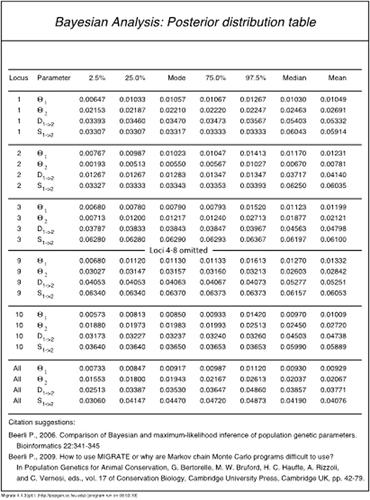下载PDF
{"title":"Population Genetic Inference With MIGRATE","authors":"Peter Beerli, Somayeh Mashayekhi, Marjan Sadeghi, Marzieh Khodaei, Kyle Shaw","doi":"10.1002/cpbi.87","DOIUrl":null,"url":null,"abstract":"<p>Many evolutionary biologists collect genetic data from natural populations and then need to investigate the relationship among these populations to compare different biogeographic hypotheses. MIGRATE, a useful tool for exploring relationships between populations and comparing hypotheses, has existed since 1998. Throughout the years, it has steadily improved in both the quality of algorithms used and in the efficiency of carrying out those calculations, thus allowing for a larger number of loci to be evaluated. This efficiency has been enhanced, as MIGRATE has been developed to perform many of its calculations concurrently when running on a computer cluster. The program is based on the coalescence theory and uses Bayesian inference to estimate posterior probability densities of all the parameters of a user-specified population model. Complex models, which include migration and colonization parameters, can be specified. These models can be evaluated using marginal likelihoods, thus allowing a user to compare the merits of different hypotheses. The three presented protocols will help novice users to develop sophisticated analysis techniques useful for their research projects. © 2019 The Authors.</p><p><b>Basic Protocol 1</b>: First steps with MIGRATE</p><p><b>Basic Protocol 2</b>: Population model specification</p><p><b>Basic Protocol 3</b>: Prior distribution specification</p><p><b>Basic Protocol 4</b>: Model selection</p><p><b>Support Protocol 1</b>: Installing the program MIGRATE</p><p><b>Support Protocol 2</b>: Installation of parallel MIGRATE</p>","PeriodicalId":10958,"journal":{"name":"Current protocols in bioinformatics","volume":"68 1","pages":""},"PeriodicalIF":0.0000,"publicationDate":"2019-10-24","publicationTypes":"Journal Article","fieldsOfStudy":null,"isOpenAccess":false,"openAccessPdf":"https://sci-hub-pdf.com/10.1002/cpbi.87","citationCount":"43","resultStr":null,"platform":"Semanticscholar","paperid":null,"PeriodicalName":"Current protocols in bioinformatics","FirstCategoryId":"1085","ListUrlMain":"https://onlinelibrary.wiley.com/doi/10.1002/cpbi.87","RegionNum":0,"RegionCategory":null,"ArticlePicture":[],"TitleCN":null,"AbstractTextCN":null,"PMCID":null,"EPubDate":"","PubModel":"","JCR":"Q1","JCRName":"Biochemistry, Genetics and Molecular Biology","Score":null,"Total":0}
引用次数: 43
引用
批量引用
Abstract
Many evolutionary biologists collect genetic data from natural populations and then need to investigate the relationship among these populations to compare different biogeographic hypotheses. MIGRATE, a useful tool for exploring relationships between populations and comparing hypotheses, has existed since 1998. Throughout the years, it has steadily improved in both the quality of algorithms used and in the efficiency of carrying out those calculations, thus allowing for a larger number of loci to be evaluated. This efficiency has been enhanced, as MIGRATE has been developed to perform many of its calculations concurrently when running on a computer cluster. The program is based on the coalescence theory and uses Bayesian inference to estimate posterior probability densities of all the parameters of a user-specified population model. Complex models, which include migration and colonization parameters, can be specified. These models can be evaluated using marginal likelihoods, thus allowing a user to compare the merits of different hypotheses. The three presented protocols will help novice users to develop sophisticated analysis techniques useful for their research projects. © 2019 The Authors.
Basic Protocol 1 : First steps with MIGRATE
Basic Protocol 2 : Population model specification
Basic Protocol 3 : Prior distribution specification
Basic Protocol 4 : Model selection
Support Protocol 1 : Installing the program MIGRATE
Support Protocol 2 : Installation of parallel MIGRATE
与迁移的群体遗传推断
许多进化生物学家从自然种群中收集遗传数据,然后需要研究这些种群之间的关系,以比较不同的生物地理学假设。MIGRATE是一个探索种群间关系和比较假设的有用工具,自1998年以来一直存在。多年来,它在所用算法的质量和执行这些计算的效率方面都稳步提高,从而允许对更多的位点进行评估。这种效率已经得到了提高,因为MIGRATE已经被开发为在计算机集群上运行时并发地执行许多计算。该程序基于聚结理论,并使用贝叶斯推理来估计用户指定的人口模型中所有参数的后验概率密度。复杂的模型,包括迁移和殖民参数,可以指定。这些模型可以使用边际似然来评估,从而允许用户比较不同假设的优点。提出的三个协议将帮助新手用户开发对他们的研究项目有用的复杂分析技术。©2019作者。基本协议1:第一步与migrate基本协议2:人口模型规范基本协议3:先验分布规范基本协议4:模型选择支持协议1:安装程序migratesport协议2:安装并行迁移
本文章由计算机程序翻译,如有差异,请以英文原文为准。



